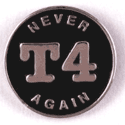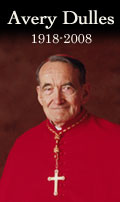
|
||
|
||
|
Sunday, March 13, 2005
"Those Who Forget the Past . . ." -- The Lessons of "Mercy Killing"
The U.S. Holocaust Memorial Museum's website has a section on the Nazi Persecution of the Disabled, including the origins of the Nazi T4 Euthanasia Program.
The T4 Euthanasia Program had its roots in Hitler's drive to develop a "master race" out of a "biologically pure" Aryan population. The forced sterilization of those suffering from hereditary disease -- a move reflected in the United States' eugenics movement -- was a precursor to the mercy killing of those deemed "uncurable." According to the HMM, planning for the Euthanasia Program was believed to be initiated in 1939. In October of that year, Hitler signed a secret authorization granting doctors the right to carry out "mercy deaths" of patients considered "incurable according to the best available human judgment of their state of health." The authorization gave physicians, medical staff and administrators immunity from prosecution for their participation in the program. Six gassing installations were subsequently established to facilitate the secret execution of children and adults with physical disabilities or mental ilness, otherwise deemed "unfit" for life. (Mentally and Physically Handicapped: Victims of the Nazi Era; also available in PDF format). Eventually, the T4 Program became public knowledge, and in August 1941 was formally halted by order of Hitler, in response to "private and public protests concerning the killings, especially from members of the German clergy." This did not bring an end to the executions, however, which secretly resumed in 1942. Rather than gassing, the executions were carried out by lethal injection and drug overdose in clinics throughout Germany into the last days of World War II, "expanding to include an ever wider range of victims: so-called asocials, geriatric patients, bombing victims, and foreign forced laborers.": During the initial phase of operations, from 1939 until 1941, about 70,000 people were killed under the Euthanasia Program. At the proceedings of the International Military Tribunal in Nuremberg (1945-1946), it was estimated that the total number of victims was 275,000 people. The Euthanasia Program instituted the use of gas chambers and crematoria for systematic murder. The experts who participated in the Euthanasia Program were instrumental in establishing and operating the extermination camps later used to implement the "Final Solution". For further documentation of the T4 Euthanasia Program, see Henry Friedlander's The Origins of Nazi Genocide: From Euthanasia to the Final Solution. In December 2004, the Royal Dutch Medical Association (KNMG) "asked the Netherlands Ministry of Health to create an independent board to evaluate euthanasia cases for each category of people 'with no free will,' a category that would include children, the severely mentally retarded and patients in irreversible comas. ("Dutch ponder 'mercy killing' rules", CNN Dec. 2, 2004). According to the Associated Press, the Groningen Academic Hospital in Amsterdam "recently proposed guidelines for mercy killings of terminally ill newborns, and then made a startling revelation: It has already begun carrying out such procedures, which include administering a lethal dose of sedatives." ("Netherlands grapples with euthanasia of babies" MSNBC, Nov. 30, 2004). The story made its rounds through the blogosphere, but as Hugh Hewitt noted in the Weekly Standard ("Death by Committee", received precious little mention by the editors and pundits in the mainstream press. Now, according to Knight Ridder News, a group of Dutch doctors are pressing the issue further by publicly admitting to killing twenty newborns, presenting themselves to public prosecutors with the intent of provoking public recognition of their actions by the Dutch Parliament: The law says people can elect suicide over continued treatment for terminal conditions, but it does not apply to children under 12. Debate over the sanctioned killing of children has been raging in the Netherlands for months and has drawn the attention of the Vatican and anti-euthanasia groups from around the world. The nation's Supreme Court first approved of euthanasia, under certain circumstances, in 1984. Ten years later, the parliament outlined rules to follow to avoid prosecution. In 2002, members of parliament voted it into law. But the law has dealt with patients who have requested death. This discussion - which is in a very preliminary stage and expected soon on the parliament's calendar - is about those who cannot request death, or voice a choice for life. "Doctors report killing of babies" Knight Ridder News (March 7, 2005). The Dutch Parliament's approval of euthanasia "under certain circumstances" is practically a myth. Euthanasia is now being performed in the Netherlands not only by consent of the patient but autonomous fiat of the physician -- as Henk Reitsema, leader of the L'Abri Fellowship in Holland, learned when he discovered the facts behind his grandfather's death. (Deadly Diagnosis in the Netherlands, by Jonathan Imbody. Family Voice January/February 2001). According to the report by Concerned Women for America, "Dutch politicians and health officials carefully emphasize a system of controls designed to ensure patient autonomy. In practice, however, those controls are a fairy tale. Dutch medical surveys reveal that in three out of four cases where doctors intervened to hasten death, the patient did not give permission." And according to a recent article in the New England Journal of Medicine by euthanasia advocates Eduard Verhagen and Pieter Sauer, infant euthanasia is unreported and widespread as well, by a rate of "15-20 cases every year -- yet only an average of three reported annually." (LifeSiteNews, March 11, 2005). It is an "irony of history," notes the International Task Force on Euthanasia, that Holland was the only occupied country whose doctors refused to participate in the Nazieuthanasia program: Dutch physicians openly defied an order to treat only those patients who had a good chance of full recovery. They recognized that to comply with the order would have been the first step away from their duty to care for all patients. The German officer who gave that order was later executed for war crimes. Remarkably, during the entire German occupation of Holland, Dutch doctors never recommended nor participated in one euthanasia death. Commenting on this fact in his essay "The Humane Holocaust," highly respected British journalist Malcolm Muggeridge wrote that it took only a few decades "to transform a war crime into an act of compassion." Those living in the United States might react with horror and moral repugnance at the news coming from the Netherlands, but we've got monsters in our own backyard to contend with. The State of Oregon has already taken the plunge by passing its own doctor-assisted suicide law in 1997, resulting in the documented deaths of more than 170 patients (I'm not sure if this one counts). And as I write this, Florida's 6th Circuit Courge Judge Greer is hell-bent -- figuratively and metaphysically -- on ensuring the death of Terri Schindler-Schiavo, brushing aside every attempt by her parents to save her life (as reported by Fr. Rob Johansen of Thrown Back, March 8, 2005). At this point, all that seems to stand between Judge Greer and Terri's demise are the efforts of Rep. Dennis Baxley, R-Ocala and the Florida legislature (as reported by Sun Sentinel March 10, 2005; further commentary on Earl Appleby of LifeMatters, Catholics in the Public Square). And, as we noted in an earlier post ("Better Off Dead" or "Not Dead Yet?" March 2, 2005), the lawyer for Terri's husband Michael, as well as the leading medical witness, are both personally involved in the movement to legalize euthanasia in the United States. No small coincidence, that. Those involved in Germany's T4 program were compelled by social Darwinianism (for whom the disabled were considered an impediment to their utopian dream of a master race); the Dutch on the other hand are motivated by a more enlightened compassion (desiring a quick and "painless" end to those for whom there is no cure), and Michael Schiavo is driven by the desire to put his wife out of her alleged misery and go on with his own life (having already done so to a certain extent, shacking up with his mistress and melting down Terri's wedding rings to make jewelry for himself). Regardless of the historical context or personal motivation, there seems to be an underlying theme to these situations: when faced with the task of caring for the disabled, and especially those deemed incurable, all those involved have subjectively decided that the patient's life is of such a quality that he or she may be deemed expendable. Suffering is regarded as the greatest offense, and killing is considered the chief act of mercy. As Dr. Bert P. Dorenbos, President Schreeuw om Leven (Cry for Life) Hilversum, Holland, observes, underlying the push for euthanasia is an attempt to get rid of suffering, and all the inconvenience and human drudgery that suffering entails. In a report on The Dutch Euthanasia Law (Public Justice Report Vol. 25, No. 3, 2002), Dr. Dorenbos examines the implications of this view: Those against euthanasia are portrayed as fundamentalists and brutal people who are willing to extend suffering rather than accept the merciful killing of those who suffer. It is quite obvious, however, that it is impossible to ban suffering from society. After the fall into sin, suffering belongs to humankind. One day it will be vanished when God's new order of righteousness and justice arrives. But for now, the answer to suffering is not killing the patient, but caring for the patient. If the doctor cannot cure the patient, the time has come to care for the patient. Euthanasia, seen in a broader context, is part of the hedonistic, egoistic, materialistic mindset by which humans think they have the right to decide about anything they want. This leads to a society in which people think of themselves first. When humans drift away from the universal principles of love, righteousness and justice, then life is at stake. To resist euthanasia is therefore to resist the deterioration of society. We increasingly face the threat that only those who are strong will live, that only the fittest will survive. Euthanasia is a Darwinist, evolutionary principle. By contrast, the true basis of human life is that the strong should take care of the weak, from conception to the grave. Humans are crying for a way out of suffering, death, and meaninglessness, often not knowing where to turn. The fight for life creates a mission field, because life is life only in the eternal perspective of the new heaven and new earth. During the apocalyptic times through which we are living, it is clear that killing humans at any point between conception and death is a brutal offense against the Creator of life. Without doubt, the judgment of such a killing society will come. Only through repentance and living in the expectation of the Lord's eternal kingdom is there a way of life on the way to life. When Dr. Dorenbos was notified of the plight of Terri Schiavo in 2003, he responded with a "warning from Holland" that Judge Greer's decision to deprive Terri of essential nutrition and hydration "is more important than the Supreme Court Decision to ban euthanasia in the United States of America," given that it would "[open] the floodgate of subjective decision making in cases of life and death": At the moment when, in the Dutch debate on euthanasia, a court ruled that withholding food and fluid is a permissible medical treatment, the road was paved for the euthanasia law currently in force in Holland. In the case of Mrs. Ineke Stinissen, who had been in coma for several years, a Dutch court ruled in 1990 that food and fluid could be withheld from her. Mrs. Stinissen died shortly afterward from starvation. The request to remove Mrs. Schiavo’s food and water came from her husband. Since then, discussion about the termination of life is no longer based on the objective fact of a patient’s terminal illness, but more and more on a subjective approach to the quality of that patient’s life and the subjective view of professional and nonprofessional persons about the right to life or death. Dr. Dorenbos should know the dangers of the subjective approach, as his country has already made the transition from formal legalization of voluntary euthanasia to covert involuntary euthanasia for the elderly, to what looks to be the impending endorsement of infanticide (but only under certain conditions) in a matter of decades. There is a memorable scene in The Thanatos Syndrome, by Walker Percy, involving a chapter-length conversation between the protagonist, Dr. Thomas More, and Father Smith, a somewhat off-kilter but perceptive priest holed up in a fire-tower: [Father Smith] "You are an able psychiatrist, on the whole a decent, generous humanitarian person in the abstract sense of the word. You know what is going to happen to you?" [Dr. More] "What?" You are a member of the first generation of doctors in the history of medicine to turn their backs on the oath of Hippocrates an d kill millions of old useless people, unborn children, born malformed children, for the good of mankind -- and to do so without a single murmur from one of you. Not a single letter of protest in the august New England Journal of Medicine. And do you know what you're going to end up doing? You a graduate of Harvard and a reader of The New York Times and a member of the Ford Foundation's Program for the Third World? Do you know what's going to happen to you?" "What's going to happen to me, Father?" "You're going to end up killing Jews." Dr. More shrugs off the priest's response. Readers may be inclined to do so as well, convinced that any mention of the Holocaust in the context of a moral argument borders on the cliche. However, it is altogether likely that, barring persistent action by our legislators and the vocal protest and opposition of fellow Americans, we will witness an increasing number of "mercy killings" such as those already happening in the Netherlands under the masque of compassion. We best heed the cryptic warning of Fr. Smith: "Do you know where tenderness always leads? "No, where?" "To the gas chamber." "I see." "Tenderness is the first disguise of the murderer." Recommended Links:
Labels: terry schiavo
|

Against The Grain is the personal blog of Christopher Blosser - web designer
and all around maintenance guy for the original Cardinal Ratzinger Fan Club (Now Pope Benedict XVI).
Blogroll
Religiously-Oriented
"Secular"
|
|
















